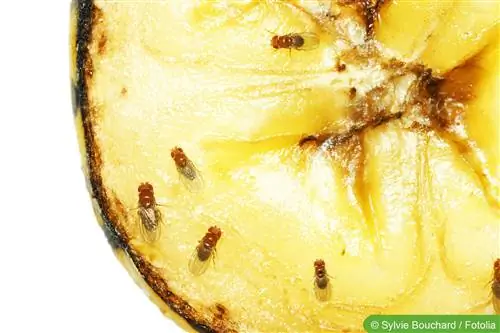- Author admin [email protected].
- Public 2023-12-17 03:39.
- Last modified 2025-01-24 12:45.
Rats are carriers of disease and are simply disgusting for many people. Nobody wants them in the garden, let alone in the house. Since many remedies that are supposed to help against rats don't really work or only work once, it's not that easy to get rid of them again. Even a rat trap is not a 100% safe thing. The animals are extremely capable of learning and if one rat is caught, the others will avoid the trap, no matter how often you move them. If you are dealing with an individual animal, the trap can be quite helpful, but with an entire family it becomes difficult.
A distinction is made between impact traps and box traps. Snap traps kill the rats, usually very quickly, without any torture. Box traps are more humane, at least as long as they are checked regularly so that the animals in them do not starve and die of thirst. It is important to place the traps on the paths of the rats. These can be recognized by traces of smear on the walls. Rats prefer to move along walls.
Although rat traps are available commercially quite inexpensively, they are usually the ones that kill rats. Live traps cost a lot more, which is why many hobbyists prefer to make them themselves. These traps have the advantage that the rats are allowed to live. They are released into the wild, as far away as possible from human habitation.
Build a rat trap
You can build fairly simple traps with little resources, but you can also build somewhat more complicated ones with a little more materials. Since you need different traps for a rat family anyway, it makes sense to try them all out.
Simple models
The easiest way is to take a tall container like a metal bucket and place it with the opening facing upwards. Smooth walls are important. The rat is not allowed to climb up them. Bait must be placed in the bucket. Rats don't eat cheese as reliably, fruit is better, but the animals really like something sweet like chocolate. Their favorite is Nutella, which is hard to resist. To get in, an entrance must be created. A small wooden board or thick folded cardboard is helpful. You can also build them a staircase out of boxes. It's best to put a few small baits on top of them, so to speak. So the rat gets to the edge of the container, jumps down and gets stuck.
- Larger, tall container that has smooth walls so that the rat cannot climb out
- A large bucket is best, preferably made of metal
- Bait, preferably Nutella, alternatively fruit or chocolate
- A staircase made of cardboard boxes, a wooden board or thick cardboard
Alternatively, you can try something different with the bucket. To do this, an empty plastic bottle is placed on a stick. Of course you have to make a hole in the bottom and in the closure. The stick must be long enough to be placed over the bucket. It is easy to attach with string on both sides, but in such a way that it can rotate. Alternatively, you can drill two holes in the bucket for the rod or use the holes for the handle. Place sticky treats in the middle and all around the bottle so that they don't fall off immediately when the rat touches them. Nutella is again suitable. The bottle must be able to rotate easily. If the rat tries to get the treats and steps on the bottle, it spins and the animal falls into the bucket.

It is important that the rat has easy access to the bait, so you have to build a “ramp” again. The bottle at the top can be placed in two ways, in the direction of travel, when the animal comes up the ramp then it can just keep walking. However, it is better if the rat has to jump onto the bottle, i.e. it is placed opposite the direction of travel or simply across the bottle. Once the rat lands, the bottle spins and the rat falls.
- Plastic bottle “sticked” with bait
- Rod for threading through
- Bucket, if possible with a removable handle (two openings for the rod)
You need some skill for the next trap. This also requires a larger container and a small wooden stick. The bait is skewered onto the rod, preferably a piece of bacon or bread. Then it is leaned against the wall in a “rat path” with the bait pointing downwards. The vessel is placed with the opening facing downwards so that the edge rests on the wooden stick. To get to the bait, the rat has to pull it away. The stick falls over and the vessel hits the ground. Of course, it must be heavy enough that it cannot be lifted out and must not get caught on the skirting board. The problem is how to get the rat out of there. You have to slide a thin wooden plate under the container and then turn it over together, but in such a way that the rat cannot jump out. Alternatively, thick cardboard or a wooden plate can be placed before setting up the trap.
- Larger vessel, for example a pot
- Wooden stick, such as a chopstick or a pencil
- Bait, something to spear
These two solutions are really easy to implement.
More complicated traps
Building a rat trap out of a box is a little more complicated. This should be a little longer, at least twice as long as a rat. An entrance will be created at both ends. The box is divided in the middle and a grid is installed. This ensures that the rat can enter from both sides and is then trapped. A mechanism that closes both doors would be quite complicated. A small hole should be drilled in the lid of both “departments” so that you can see inside. The bottom of the box is sawn out. It serves as a rocker to trigger the lock that closes the exit. Store the rocker in the middle of the box.
The entrances on both sides should be approximately 60 mm in diameter. They can be closed from the inside with a metal lid. When empty, a mechanism keeps it open. If a rat enters the interior and the rocker installed, its weight moves the mechanism and the metal cover falls in front of the entrance.
The mechanics are simple. The movable floor is connected to a shaft made of iron wire at the bottom. The shaft must protrude from one side as a lever. The floor is fitted into the box so that the shaft is movable, otherwise the rocker cannot tip over. Of course, the metal lids must close the opening tightly, i.e. be large enough. The good thing is that they are quite heavy so that the rat cannot push them open. It is better to install a small latch as a safety device to prevent it from being pushed open. It is important that the opening is accessible from the outside so that the trapped animal can be released in a suitable place.
- Crate at least twice as long as a rat
- Grid for separation
- 2 tin lids
- Shaft made of iron wire
- Lever
- Small jack
Live traps are much more humane, even if they only target rats. They are absolutely intelligent animals that are suitable for more than just laboratory animals. They can be tamed and trained, not many animals can do that. You don't have to have a lot of technical skill when building a trap. There are very simple options. It always depends on the intelligence of the rodents and how easy they are to catch. What is certain is that animals are capable of learning. If you catch a rat from a family, no member of that family will fall into the same trap. You have to come up with something new. Necessity is the mother of invention. What is important is the correct location, on a rat path.






